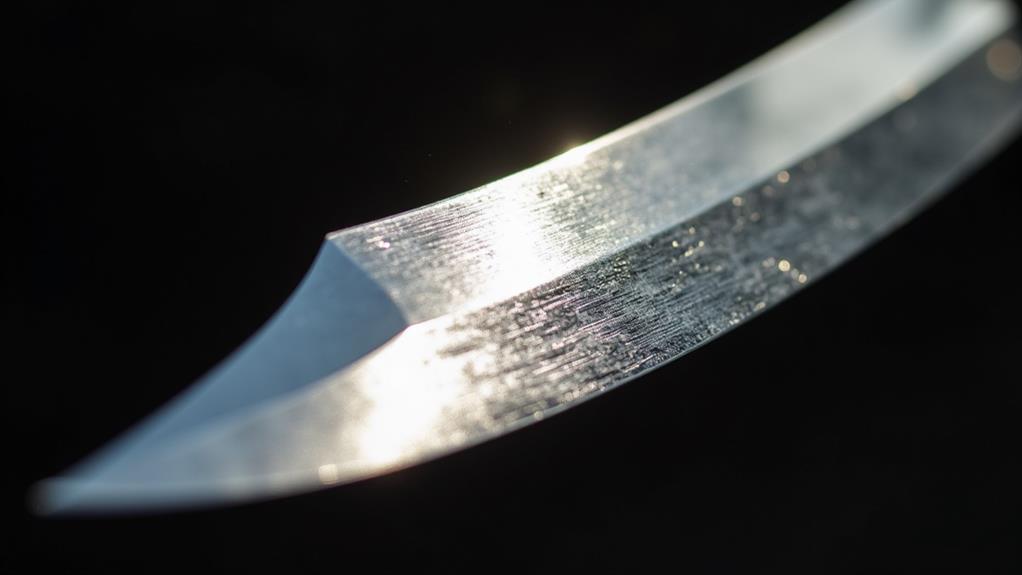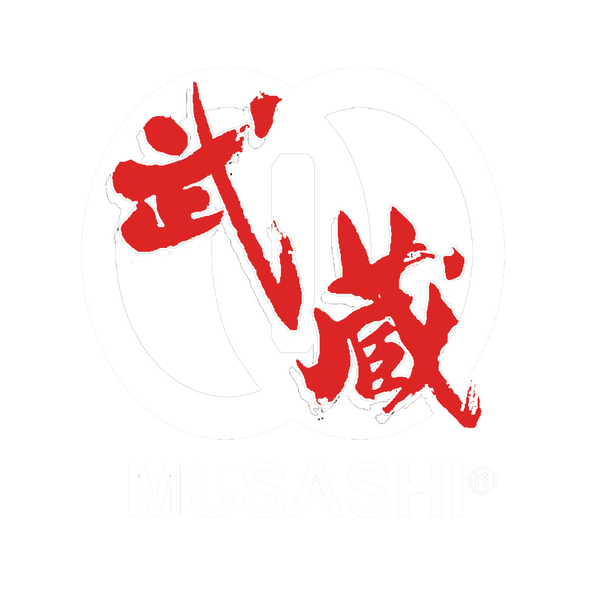
A katana is made up of many awesome parts that work together to make it an amazing sword. The blade, which is called ken, has cool things like the nagasa (how long it is), kissaki (the pointy end), ha (the sharp edge), and sori (the curve). All of these help the sword work really well. The handle, or tsuka, is wrapped in special stuff called tsuka-ito to make it easy to hold. Often, there's ray skin (samegawa) under the wrapping to make it even comfier. The katana also has a special cover called a saya to keep it safe. Other cool parts like the tsuba (a guard) and mekugi (little pegs) make the sword safer and prettier. Each part of the katana is important and shows how amazing these swords are!
Key points
- The katana has two main parts: the blade (ken) and the koshirae (the handle, guard, and cover). These make the sword work well and look cool.
- The blade has neat stuff like how long it is (nagasa), its curve (sori), the pointy end (kissaki), and a special line (hamon) that shows how well it's made.
- The handle (tsuka) is wrapped in special stuff (tsuka-ito) to make it easy to hold. There's often ray skin under this to make it comfy and help when you hit things.
- The cover (saya) keeps the blade safe and has things like a cord (sageo) to carry it and a tip (kojiri) to protect it.
- The guard (tsuba) keeps your hands safe and looks really cool. Other decorations like menuki make the sword look even better and easier to hold.
What a Katana Looks Like
What makes a katana so special? Well, it's not just a sword - it's like a symbol of honor and being really good at making things. The katana has two main parts: the blade, which is called "ken," and the koshirae, which includes the handle, the guard, and the cover.
The blade, or "nagasa," is usually about two shaku long (that's about 60 cm), but some are different sizes for different ways of fighting. Cool parts of the blade include the "kissaki" (the pointy end), the "ha" (the sharp edge), the "mune" (the back edge), and the "sori" (the curve). All of these parts help the katana work really well in a fight and make it look super cool.
The handle, called "tsuka," is wrapped in special stuff called "tsuka-ito" to make it easy to hold. Often, there's tough "samegawa" (ray skin) under this to make it even more comfy to hold.

Cool Parts of the Blade
When you look closely at a katana blade, you can see how it's both beautiful and really good at what it does. Each part of the blade is super important and shows how skilled the person who made it was. Here are some of the coolest parts:
-
Nagasa: This is how long the blade is, usually about two shaku (that's about 60 cm).
-
Sori: This is the curve in the blade. It helps you use the sword better.
-
Kissaki: This is the sharp point at the end. It's great for stabbing and cutting.
-
Hamon line: This is a wavy line on the blade that looks really cool and shows how well the sword was made.
There's also a part called the habaki that helps keep the blade in its cover and makes it stronger. The sharp edge is made super carefully so it can cut really well.
The shinogi is a line that makes the blade stronger, and the shinogi-ji is the part below it that helps shape the blade. When you see things like the hamon, you can tell the blade isn't just for fighting - it's also a work of art!
All these parts together make a katana more than just a sword. It's like holding a piece of history and culture in your hands!
Cool Stuff About the Handle
The handle of a katana, called the Tsuka, is just as cool as the blade. It's super important for how the sword works and feels when you use it. When you hold the Tsuka, you can feel how it connects you to the blade, making you feel confident and in control.
The handle is usually made of wood, and it's not just there to look pretty. It's made to be easy to hold onto when you're using the sword. It's wrapped in something called Tsuka-Ito, which can be made from silk, cotton, or leather. This wrapping feels great in your hand and helps you keep a good grip, even when things get intense.
Under the wrapping, there's something called Samegawa, which is ray skin. This makes the grip even better and helps absorb shock when you hit things, making your strikes stronger and more accurate. To keep the handle attached to the blade, there are little wooden pegs called Mekugi. These make sure the handle stays on tight when you're swinging the sword.
To make the handle even cooler, there are decorations called Menuki hidden under the wrapping. These make the sword look awesome and give you an even better grip, making you feel even more connected to this amazing weapon.
The Cover and Its Cool Parts
The Saya is like a special cover for the katana. It keeps the blade safe when you're not using it.
When you wear your katana, the saya doesn't just protect the blade - it also makes you feel connected to hundreds of years of history.
The saya has some really cool parts that make it work better and look awesome:
- Sageo: This is a cord, often made from silk or cotton, that ties the katana to your waist. It helps you get to your sword quickly and stops you from accidentally dropping it.
- Kurikata: This is a small button on the saya. It helps hold the sageo and makes the cover look even cooler.
- Kojiri: This is the tip of the saya. It protects the end from getting damaged and often has really cool designs on it.
- How to Wear It: Usually, you wear the saya with the sharp edge of the katana facing up. This makes it easy to pull out quickly for practice or fighting.
When you know about all these parts, you can really see how awesome and useful a katana is. It helps you feel even more connected to this amazing sword.

How It Looks and How It Works
While the saya keeps the katana safe, the sword itself is super cool to look at and use. Every part is made really carefully, so it looks great and works well. The blade of the katana has a special wavy line called a hamon that shows how skilled the person who made it was. This line also makes the sword look really cool.
Here's a quick look at some important parts and why they're awesome:
| Part | What It Does | How It Looks |
|---|---|---|
| Tsuba | Protects your hands | Has really cool designs that show Japanese culture |
| Samegawa | Helps you hold the handle better | Has a unique texture that looks awesome |
| Tsuka-ito | Wraps around the handle | Adds cool colors and makes the sword look interesting |
The tsuba is the guard that keeps your hands safe and has amazing artwork on it. The samegawa (ray skin) on the tsuka helps you hold onto the sword better and feels great in your hand. Every time you swing the katana, you can feel how well-balanced it is. This makes it more than just a weapon - it's like holding a piece of history and art. When you understand all the cool parts of your katana, you'll feel like you're part of an awesome tradition that's been around for a really long time.
Frequently Asked Questions
What Are the Parts of a Japanese Katana?
When you look at a Japanese katana, you'll see it has lots of cool parts. The blade is made in a special way, and each part has an important history. Taking care of all these parts is super important. When you know about all this stuff, you'll think the katana is even cooler!
What's the Round Thing on a Katana?
The round thing on a katana is called the tsuba. It's there to protect you and make the sword look cool. When you know about how katanas are made and how to take care of them, you feel like you're part of a special group of people who love martial arts.
What's the Cover of a Katana Called?
The cover of a katana is called a Saya. It looks really cool and has a lot of history. It's made from good stuff and keeps your blade safe. When you have a Saya, it shows you're connected to the old samurai culture, which is super cool.
What's the Sharp Part of a Katana Called?
The sharp part of a katana is called the Ha. It's really important for cutting things. If you learn how to take care of it, you'll understand why it's so special in history. Knowing about this helps you feel connected to all the cool sword fighters from long ago.
Conclusion
So now you know all about the cool parts of a katana! Understanding what each part does helps you see how awesome these swords really are. Every piece, from the blade to the handle and the cover, is important for how the sword works and how it looks. Whether you like to collect swords or just think they're neat, knowing about all these parts makes katanas even more interesting.
A katana isn't just a weapon - it's like a piece of art that shows how skilled the person who made it was. It's also a big part of Japanese culture that people all over the world think is really cool. If you want to see some real katanas and all their awesome parts up close, our Store Musashi Swords has lots of great ones that show off all the cool stuff we talked about in this article.


